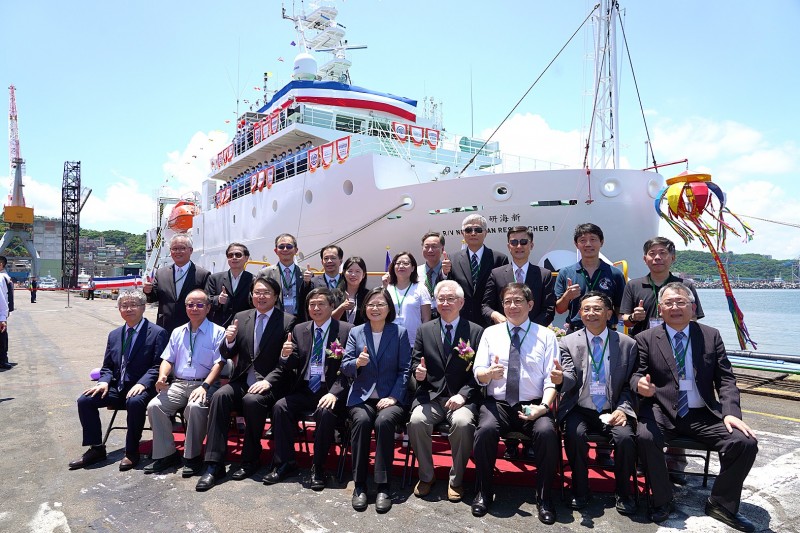《TAIPEI TIMES》 President Tsai inaugurates new research vessel

President Tsai Ing-wen, front center, Minister of Science and Technology Wu Tsung-tsong, front fourth right, and guests attend an inauguration ceremony for the R/V New Ocean Researcher 1 at the Port of Keelung yesterday. Photo courtesy of the Ministry of Science and Technology via CNA
By Lin Chia-nan / Staff reporter
President Tsai Ing-wen (蔡英文) yesterday inaugurated the nation’s newest research vessel at a shipyard in Keelung as she vowed to make Taiwan a prosperous and sustainable maritime country.
The 2,155-tonne R/V New Ocean Researcher 1, one of three ships commissioned by the Ministry of Science and Technology from CSBC Corp, Taiwan (台船), was built at a cost of nearly NT$646 million (US$21.86 million) and is to take over the mission of the R/V Ocean Researcher I, which stopped operations earlier this year.
It is part of the new research fleet, along with the R/V New Ocean Researcher 2 and the R/V New Ocean Researcher 3 — also built by CSBC and inaugurated last year — and the R/V Legend, built by a Singaporean shipbuilder and inaugurated in 2018.
Yesterday was a big day for the nation, as the R/V New Ocean Researcher 1, built by a domestic shipbuilder, was finally inaugurated after years of planning, Tsai told a ceremony at CSBC’s Keelung shipyard.
The ship would embark on trips to Guam and Palau to survey typhoon genesis hotspots in the western Pacific, as well as the Mariana Trench and the North Equatorial Current, under the ministry’s “Sailing to the Blue Sea” program, Tsai said.
The surveys would advance people’s understanding of the environment, improve natural disaster response, and allow the nation to contribute to the global community and promote sustainable development in the region, she said.
As a nation surrounded by waters, Taiwan is intimately tied to the ocean in many aspects, but for a long period, Taiwanese lacked oceanic education and turned their backs on the ocean, Tsai said, citing remarks by author Liao Hung-chi (廖鴻基), whose books focus on the ocean.
However, society has renewed its understanding of the ocean, thanks to efforts by the previous research vessels over the past three decades, she said, adding that the new fleet would expand the scope of research on existing foundations.
“Let us build a prosperous and sustainable maritime country,” Tsai said, as she wished the new ship smooth sailing.
The “Sailing to the Blue Sea” program encourages marine research in distant seas, Deputy Minister of Science and Technology Lin Minn-tsong (林敏聰) said.
With the ships using state-of-the-art instruments, the ministry aims to establish a “four-dimensional “observation network to deepen the nation’s understanding of the marine environment and weather conditions to promote a sustainable marine environment, he said.
The R/V New Ocean Researcher 1, which is to be transferred from the ministry to National Taiwan University’s Institute of Oceanography for management, is scheduled to visit Guam in December, but the plan is subject to change due to the COVID-19 pandemic, institute director Jan Sen (詹森) said.
The institute plans to install a Doppler radar to collect meteorological data within a 150km radius vertically and horizontally, he said, adding that such radar systems are only found on Australian, Japanese and US research vessels.
The ship’s state-of-the-art instruments include shallow and deep-sea multibeam echosounders that would allow scientists to produce high-resolution 3D maps of sea floors, Jan said.
The institute also displayed several instruments that could be deployed on the vessel, including a data buoy for ocean and weather observations, a Seaglider autonomous underwater vehicle and a remotely operated vehicle.
Building the research ships to complex scientific instrument specifications was a challenge for CSBC, which was used to constructing large commercial ships, chairman Cheng Wen-lon (鄭文隆) said.
After the R/V Ocean Researcher V shipwreck in 2014, CSBC was required to adopt stricter safety standards used for passenger ships when building the research ships, he added.
Another CSBC member said the company might face fines for its delay in transferring the ship and that it is negotiating about related matters with the ministry.
Lin said the ministry would handle the matter according to its contract with the firm.
新聞來源:TAIPEI TIMES



















